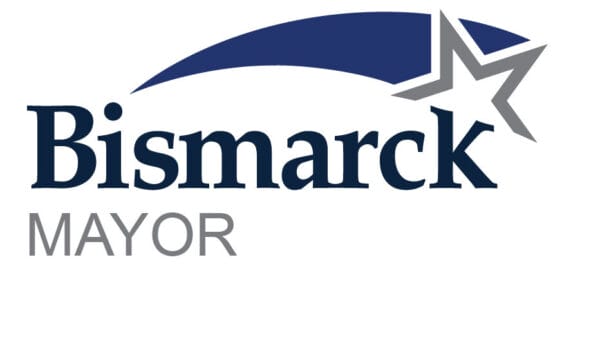Mike Schmitz, Mayor of Bismarck
Before the first snowflake, Bismarck Airport prepares for snow response to ensure customer safety
When the calendar flips to fall months and temperatures begin to drop, North Dakota winters, notorious for snow and bitter conditions, are not far behind. Bismarck Airport’s busiest time of year is these winter months, often serving as the conduit for individuals and families traveling to a warmer locale, as well as connecting businesses to the rest of the country.
The Federal Aviation Administration classifies the Bismarck Airport as a primary, non-hub commercial service airport critical to supporting the demands of the nation’s aviation system. Within the structure of the City of Bismarck’s municipal government, Bismarck’s airport is an enterprise fund, meaning the department charges for services it provides to outside customers. In this way, enterprise funds function similarly to private business enterprises.
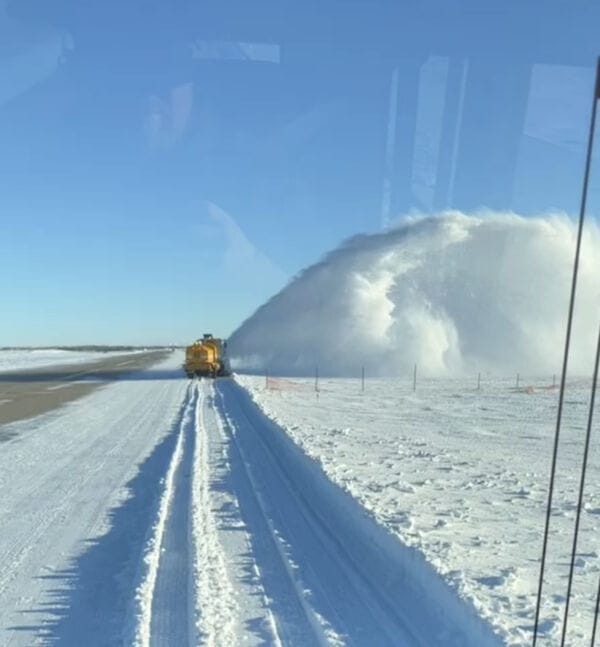

The Bismarck Airport began providing airline operations in 1931, with Northwest Airlines making its inaugural flight. Today the airport will experience 8 to 10 commercial flights during summer months, and up to 15 flights a day during winter months. This increased workload, combined with the elements, can prove challenging at times. But through preparation and communication, airport staff work to ensure the public is not impacted, in an industry that puts a premium on safety and timing.
Last year, as the COVID-19 pandemic began to release its white-knuckle grip on much of the travel industry, Bismarck Airport tallied 241,927 enplanements and 239,779 deplanements (481,706 total passengers) over 31,630 flight operations that also carried 3,582,112 pounds of cargo tonnage. While these numbers still have yet to rival 2019’s 618,000 total passenger count, this past summer’s travel numbers reflect the area’s continued desire to fly. While virtual business meetings may have altered the priority that business once placed on traveling for in-person meetings, this winter is still expected to be busy.
Winter Season Preparation
In September of every year, Airport staff and the various tenants that provide service to the airport’s operations meet to talk about the upcoming winter’s snow removal operations. Everything is discussed, from priorities for snow removal on runways, the stock and use of snow and ice chemicals, and how information will be shared during smaller and larger snow events.
“During the meeting, there isn’t a hierarchy,” explained Matthew Remynse, the Marketing and Operations Manager with the Airport. “We spend three hours talking about the upcoming winter operation. If someone has a question, we will defer to the operations or maintenance staff that has the most knowledge on the subject. Our goal is make sure our snow removal operation can operate as well as it can, and in a safe manner.”
Following that meeting, staff run through in-house training to become familiar with processes they will be using potentially for the next six to seven months. The refresher gives operators real-time experiences on different calls that could happen and ensures that all equipment is in good running order before it is ever called upon.
Being ready for snow is critical in a state that could experience snowfall from October through April. Last year’s winter season was one to remember, with 101.2 inches of snowfall, just four-tenths of an inch off the all-time mark set in 1996-97. Last winter was characterized by a handful of large snow events, including a 24-inch storm in November and a 21-inch blizzard in December. In early 2023, heavy snowfall occurred in late February and early March. Managing a near-record amount of snowfall is never easy, but large snow events bring with them a myriad of challenges.
Communication about the status of the runway generally centers around when flights are arriving or leaving. When there are contaminants on the runway there are, at a minimum, eight runway condition reports completed that day, but that number can jump to 10 to 15 reports depending on changing conditions.
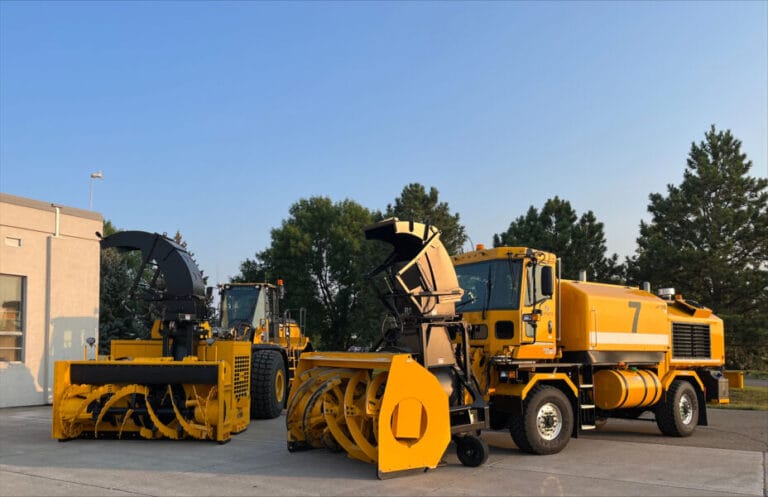
Combating Snow
The airport removes its own snow, with the exception of a third-party operator that manages snow removal in its customer parking lots sprawling to the west of the terminal. Summer months are also spent repairing and maintaining equipment, as well as gathering various parts to ensure the airport’s 18 pieces of snow removal equipment are ready for winter.
“If we are down a sweeper, we are down 50 percent of our production, so if something breaks, we need to be able to get it up and running right away,” Remynse said. “We have our own mechanics and stock a lot of things like cutting edges, deicing fluid, sweeper wafers, and common spare parts.”
When snow begins to fall, there is no time to run for supplies. Everything the organization needs must be on hand. The airport always has a supply of fine-grain sand and runway deicer fluid available for use on airfield surfaces. Additionally, airlines stock up on deicing fluids.
“We can’t wait for snow to accumulate,” Airport Director Greg Haug said. “Our response starts right when the storm starts and precipitation begins to fall.”
“The primary reason we don’t have the City’s Public Works Department remove our snow is because when we are moving snow, they are also moving snow,” Remynse said. “When it starts snowing, we can’t wait for an inch to fall to begin our removal operations. We may start to activate our operations if as little as an eighth of an inch of contaminant has fallen.”
At an airport, snow is best dealt with immediately, so it does not get a chance to compact or turn into ice. A slippery runway surface could be catastrophic for an airplane traveling hundreds of miles an hour as it lands or departs.
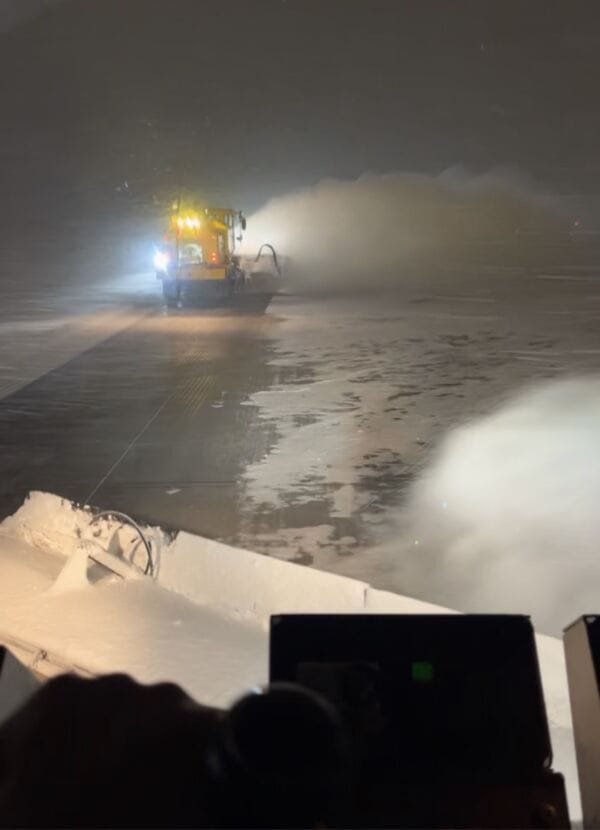
“Once you end up with compacted snow, then it becomes difficult to manage and can lead to poor runway conditions,” Remynse said. “Ice and planes don’t mix.”
Snow isn’t the only concern, as a slushy mixture of moisture and snow can also create an unsafe surface. Because of this airport equipment operators use runway brooms to remove contaminants from runways.
“We focus on the center line of the runway with brooms,” Remynse said. “A lot of airports have switched to doing it this way. When you use plows, it can create compacted snow that turns into ice or snow glaze. If you use brooms, you are right down to the pavement and you get a much better braking action. We use the plows on ramps and taxiways where aircraft are operating at slower speeds. If we can keep up with other parts of the airfield, we will get to them, but we may close other surfaces so we can keep the main runway open.”
Snow is also challenging once it is off the runway surfaces. It needs to be stored somewhere and the airport regulations only allow for piles of snow in certain areas.
“We’ve had to get creative and close down some of our surfaces in order to move snow,” Remynse said. “We have to be able to maintain wing tip clearances while aircraft are on the ground. Last winter, some of the airfield surfaces were getting close to the maximum allowable clearance height so airport operators had to go in after the snow event and blow snow back for days. We also have a lot of signs, that help direct pilots after landing, alongside our runways that we needed to dig out with each snow event.”
A portion of airport staff are dedicated to the removal of snow on the runways, others are needed to remove snow along roads on the airport property and sidewalks leading to the terminal.
“Several of the operations staff have the ability to operate some of the big snow removal equipment, too,” Haug said. “This flexibility is critical because we can call them in for duty when it’s all hands on deck.”

Partner Organizations at the Airport
Airlines providing service to and from Bismarck Airport traditionally are responsible for equipment preparation that interacts with their aircraft. This means the warmer fall months are spent preparing trucks and boom lifts that are used to deice their planes.
“Airlines get their equipment ready and then assure all their personnel are trained,” Remynse explained. “They will send their supervisors and key personnel to get deicer training at one of their airline hubs.”
When it comes to deicing aircraft prior to takeoff, there are typically a pair of fluids that are used. The first, Type 1, is delivered to the exterior of the aircraft at 180 degrees and removes frost or snow accumulation. A second type of fluid, Type 4, can be used when it is snowing. This secondary fluid prevents ice and snow accumulation prior to takeoff, and actually slides off the plane during takeoff, giving way to an aircraft’s anti-icing system that counters ice accumulation while the plane is airborne.
Aircraft must be deiced in specific locations at the airport in order to keep the chemicals in the proper stormwater infrastructure. Though this process will add extra time to a flight, airlines typically include time for this process in their flight timing. The airport owns and maintains two backup deice trucks that the airlines can use in the event their trucks fail.
“The airport took it upon themselves to create redundancy for deicing trucks, in the event the airlines’ trucks break down,” Haug said. “One thing the airport does try to ensure is that the airport and airlines stay operational. We can plow all day, but if a deice truck is broken and an airline can’t deice their aircraft, they aren’t going anywhere.”
Communication between the airlines and the airport is paramount during a storm. A “snow desk” is established during inclement weather, even when the tower is shut down from midnight to 6 AM. When the “snow desk” is implemented, radio alerts are sent out every six minutes to any airplanes that could be traveling to Bismarck, or may need to access Bismarck as an emergency landing location. If this occurs, the pilot can speak directly to operations staff for the latest information, and the snow desk operator can get the equipment off the runway.
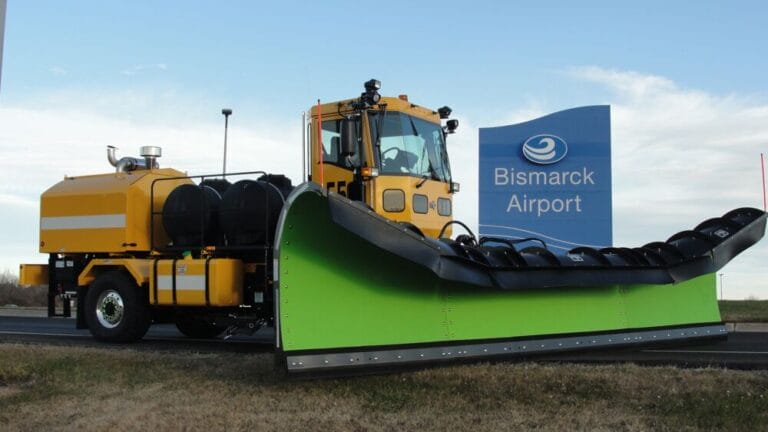
Passenger Best Practices
When it comes to winter travel, the best practice is to plan ahead, watch the weather and arrive early. If a passenger is coming to Bismarck from out of town, this could mean staying overnight in town prior to the flight, versus trying to travel to Bismarck the day of the flight.
“At times, the airport has been criticized because we are open when roads or the interstate may be closed,” Haug said. “But we do what we can to keep flights operating at all times so at least people at the airport can gain access to commercial flights.
Remynse said he would always allow at least a 90-minute window from the time you arrive at the terminal, to the time your flight departs.
“United has a cutoff of 45 minutes prior to takeoff,” Remynse explained. If you show up an hour before your flight, you are in line for 15 minutes to get bags checked, you could miss your flight.”
“I always make sure I’ve downloaded the app of the airline I’m flying on,” Haug said. “And then I’ll check in early for flights. You can check in up to 24 hours in advance. That way, if things got jammed up at the airport and flights were delayed and people from other flights are trying to get out early, you have a guaranteed seat. Your priority is so much higher than someone checking in later.”
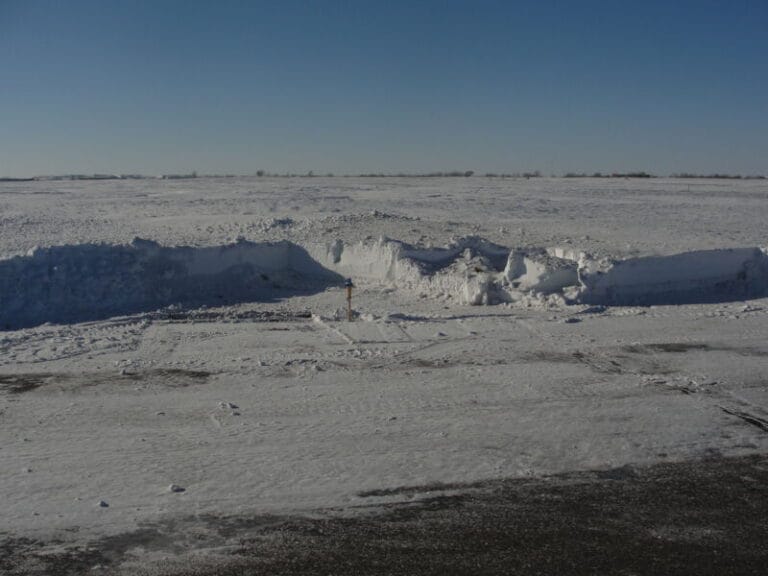
One way the customer experience has been sped up at the Bismarck Airport is the Transportation Security Administration’s installation of new CT baggage scanners earlier this year. This new technology means passengers no longer have to remove items from their bags when going through the security checkpoint.
“When you walk up to the machine, you don’t need to take out your laptops and liquids anymore,” Remynse said. “The CT machines are amazing. I’ve gone through other airports recently that didn’t have them, and I had my liquids and laptop buried. It takes a lot more time to take that all out and put it back in. It can be a challenge.”
The CT scanners are just one more way Bismarck Airport improves their customers’ experience when flying the blue skies enveloping the Bismarck Airport.
“From our customers’ perspective, we have a safe facility for aircraft to operate at,” Remynse said. “That is our goal. We work 24 hours a day to ensure that will happen.”
